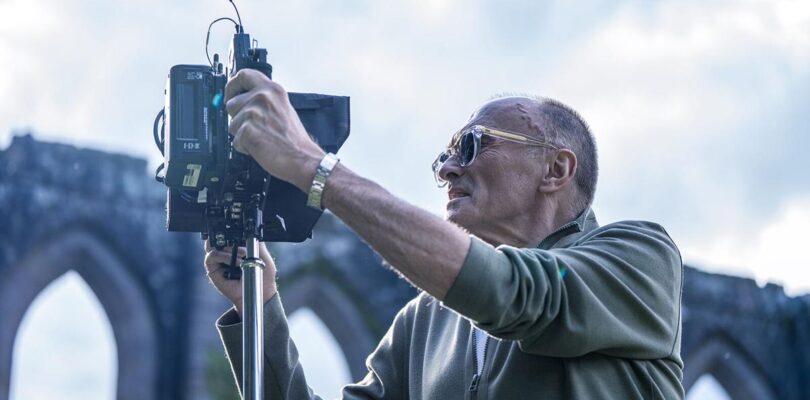LOS ANGELES — When Danny Boyle, the Oscar-winning filmmaker behind such movies as “Trainspotting” and “Slumdog Millionaire,” makes a horror film, it often has a way of landing close to home. His 2002 thriller “28 Days Later” was actually in production when the attacks of Sept. 11, 2001 occurred, and its haunting postapocalyptic imagery of empty streets and a world turned upside down made it a key movie to convey the fears of the post-9/11 era.
A new sequel, “28 Years Later,”, captures the anxieties of right now in much the same way that the original spoke to its moment, evoking a contemporary sense of isolation, despair and a world long past saving. As with “28 Days Later,” the visual style of “28 Years Later” is an inseparable part of the experience, giving it a disconcerting, disorienting energy. Where the original used consumer-grade digital video cameras to innovative effect, much of “28 Years Later” was shot using iPhones.
“One of the interesting questions with an apocalypse movie is: What do you look forward to? What do these people have to aim for?” says Boyle, director of both “Days” and “Years.” “They’re not aiming for a holiday or a good job qualification. So all their focus probably goes into the lineage, the child being brought up in a certain way and taking their place. And the value that’s expressed is how precious their homeland is, its status. So we wanted something that suggested that intensity.”
The new film reunites much of the original movie’s core creative nucleus, bringing together Boyle with screenwriter Alex Garland, cinematographer Anthony Dod Mantle and producer Andrew Macdonald. In the years since their first zombie breakout, Boyle and Mantle both won Oscars for their work on 2008’s “Slumdog Millionaire” and Garland moved into directing, making films such as “Ex Machina” and last year’s “Civil War.”
Though they keep in touch and frequently show each other their works-in-progress, Boyle and Garland have not officially collaborated since 2007’s “Sunshine,” written by Garland and directed by Boyle. It was the making of that film that precluded them from participating more deeply in the 2007 sequel “28 Weeks Later,” directed and co-written by Juan-Carlos Fresnadillo (though Boyle did shoot some second-unit work).
“It was a feeling of: Oh, my God, this is original and different and ambitious,” says Boyle of his first time reading Garland’s script for what would become the new film. “Because it’s also an especially English film, and the first film was as well — that was one of the very unusual things about it.
“Obviously COVID had happened and Brexit,” he adds. “Traumas that were unique to Britain, and some that were worldwide, that can’t help but bleed into the film.”
Boyle, 68, has a playful gregariousness that often masks the ferocity of his commitment and vision. Already deep into a worldwide publicity tour and accustomed to talking extensively about “28 Years Later,” he’s joined on our Zoom call by Garland. “You’ll notice I’m in complete flow mode,” he tells Garland with a laugh.
Garland, 55, is at home in London, while Boyle is in a hotel room in Rome. “Those are definitely not your curtains,” cracks Garland while examining his friend’s tastefully nondescript surroundings in a Zoom window.
If “28 Days Later” is often credited with popularizing the idea of “fast zombies” — bloodthirsty creatures that move with superhuman speed as opposed to the lumbering beings of the George A. Romero classics — the new film introduces some additions to the mythos.
Now we get the “Slow-Lows,” bottom-feeders who slither on the ground and survive off leftovers from other creatures: earthworms or other easy-to-catch prey. More terrifying are the Alphas — zombies on steroids, big and strong, with a penchant for ripping the heads off people with their spines still attached.
“We were just sort of kicking stuff around and it was like: What would have changed?” says Garland. “How might the infection have played on different people with different physiologies? Some kind of acknowledgment of evolution — that maybe some kind of latent predisposition or a mutation or something would push some in one direction and others in another direction.”
In “28 Years Later,” the British mainland, overrun by infected monsters, has been quarantined from the rest of the world due to the viral outbreak from the first film. Survivors have been left to fend for themselves. On a small island off the northeast of England, connected to the mainland by a causeway that becomes uncrossable with the daily tides, a largely agrarian community of those not infected with the world-killing “rage virus” has banded together, creating something akin to normalcy in their new society.
A father, Jamie (Aaron Taylor-Johnson), takes his teenage son Spike (Alfie Williams) on a journey to the mainland where the boy can kill his first infected, a crucial rite of passage in this new age. Spike’s mother, Isla (Jodie Comer), has been overcome by a mysterious illness that causes her to be overcome by disassociative spells. Having heard rumors of a mythical doctor (played with a chilling calm by Ralph Fiennes) who could possibly help, Spike sneaks off with her for a treacherous expedition to the mainland.
Finding just the right story that felt worth telling took some time.
“It was a few years ago that we talked about a script,” says Boyle, looking at Garland, “and you actually did a script, which was a very good script, but it didn’t get any traction between us, did it?”
Garland recalls crafting a “Years” script in which Chinese Special Forces attempted to get to the source of the original outbreak in order to find a cure, only to encounter another military force there intending to weaponize it.
“And really what happened,” recalls Garland, “Danny’s probably got a softer way of stating this, is I handed that script in, [and] it was a perfectly serviceable script, but it was generic. There’s a funny thing that happens when you offer something up to people, which is that if they make a criticism that you half know, you get this sort of sinking feeling because you think, ‘Yeah, no, that’s true.’ And so I dropped it and then started work on another script, which was the one that Danny ended up making into a film.”
What Garland created was in fact a new trilogy of films, with scripts completed for two and an outline for the third, which is still to be written. The second film, titled “28 Years Later: The Bone Temple” has already been shot by director Nia DaCosta and, according to producer Macdonald, is nearly finished. It is expected to be released early next year. Cillian Murphy, the wandering survivor of the original film, is an executive producer on “28 Years Later” and is said to have an expanding role across the next two films. (“He’s coming,” says Macdonald. “We’ve done some filming with him, let’s just say that.”)
Having the new story land as a trilogy was unexpected but not unwelcome.
“I remember asking Alex, ‘Define the three scripts, go on then,’ because I like having a reminder of where we started,” says Boyle. “And I remember Alex saying the first film’s about grief and the nature of family, and the second film’s about the nature of evil, and the third film’s about the nature of redemption. I remember that vividly. And you cherish that — and then you investigate.”




